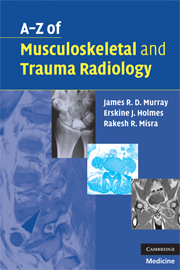Book contents
- Frontmatter
- Contents
- Acknowledgements
- Preface
- List of abbreviations
- Section I Musculoskeletal radiology
- Achilles tendonopathy/rupture
- Aneurysmal bone cysts
- Ankylosing spondylitis
- Avascular necrosis – osteonecrosis
- Femoral-head osteonecrosis
- Kienböck's disease
- Back pain – including spondylolisthesis/spondylolysis
- Bone cysts
- Bone infarcts (medullary)
- Charcot joint (neuropathic joint)
- Complex regional-pain syndrome
- Crystal deposition disorders
- Developmental dysplasia of the hip (DDH)
- Discitis and vertebral osteomyelitis
- Disc prolapse – PID – ‘slipped discs’ and sciatica
- Diffuse idiopathic skeletal hyperostosis (DISH)
- Dysplasia – developmental disorders
- Enthesopathy
- Gout
- Haemophilia
- Hyperparathyroidism
- Hypertrophic pulmonary osteoarthropathy
- Irritable hip/transient synovitis
- Juvenile idiopathic arthritis
- Langerhans-cell histiocytosis
- Lymphoma of bone
- Metastases to bone
- Multiple myeloma
- Myositis ossificans
- Non-accidental injury
- Osteoarthrosis – osteoarthritis
- Osteochondroses
- Osteomyelitis (acute)
- Osteoporosis
- Paget's disease
- Perthes disease
- Pigmented villonodular synovitis (PVNS)
- Psoriatic arthropathy
- Renal osteodystrophy (including osteomalacia)
- Rheumatoid arthritis
- Rickets
- Rotator-cuff disease
- Scoliosis
- Scheuermann's disease
- Septic arthritis – native and prosthetic joints
- Sickle-cell anaemia
- Slipped upper femoral epiphysis (SUFE)
- Tendinopathy – tendonitis
- Tuberculosis
- Tumours of bone (benign and malignant)
- Section II Trauma radiology
Paget's disease
from Section I - Musculoskeletal radiology
Published online by Cambridge University Press: 22 August 2009
- Frontmatter
- Contents
- Acknowledgements
- Preface
- List of abbreviations
- Section I Musculoskeletal radiology
- Achilles tendonopathy/rupture
- Aneurysmal bone cysts
- Ankylosing spondylitis
- Avascular necrosis – osteonecrosis
- Femoral-head osteonecrosis
- Kienböck's disease
- Back pain – including spondylolisthesis/spondylolysis
- Bone cysts
- Bone infarcts (medullary)
- Charcot joint (neuropathic joint)
- Complex regional-pain syndrome
- Crystal deposition disorders
- Developmental dysplasia of the hip (DDH)
- Discitis and vertebral osteomyelitis
- Disc prolapse – PID – ‘slipped discs’ and sciatica
- Diffuse idiopathic skeletal hyperostosis (DISH)
- Dysplasia – developmental disorders
- Enthesopathy
- Gout
- Haemophilia
- Hyperparathyroidism
- Hypertrophic pulmonary osteoarthropathy
- Irritable hip/transient synovitis
- Juvenile idiopathic arthritis
- Langerhans-cell histiocytosis
- Lymphoma of bone
- Metastases to bone
- Multiple myeloma
- Myositis ossificans
- Non-accidental injury
- Osteoarthrosis – osteoarthritis
- Osteochondroses
- Osteomyelitis (acute)
- Osteoporosis
- Paget's disease
- Perthes disease
- Pigmented villonodular synovitis (PVNS)
- Psoriatic arthropathy
- Renal osteodystrophy (including osteomalacia)
- Rheumatoid arthritis
- Rickets
- Rotator-cuff disease
- Scoliosis
- Scheuermann's disease
- Septic arthritis – native and prosthetic joints
- Sickle-cell anaemia
- Slipped upper femoral epiphysis (SUFE)
- Tendinopathy – tendonitis
- Tuberculosis
- Tumours of bone (benign and malignant)
- Section II Trauma radiology
Summary
Characteristics
Sir James Paget described the disease in 1877 as a chronic inflammatory remodelling disease of bones. He labelled the condition osteitis deformans.
Characterised by bony thickening and enlargement secondary to increased bone turnover.
The bone is weak and brittle due to abnormal bone structure.
Unknown aetiology (possible link with paramxyovirus) occurring in approximately 3% of the population over 40.
Environmental and family clustering is seen – 7% males in Lancashire (north-west UK).
Clinical features
Pain is the commonest symptom, but most patients asymptomatic.
Monostotic or polyostotic.
Sarcomatous change within the abnormal bone is the most sinister complication – said to be 1%.
Other complications include pathological fractures, bony impingement on nerves and secondary arthritis.
Deafness may occur secondary to nerve impingement or involvement of the ossicles.
Frequently affected bones include the pelvis, lumbar and thoracic vertebrae, proximal femur, calvarium and tibia.
High-output heart failure is a rare complication.
Radiological features
Thickened coarse trabeculae with cortical enlargement.
Cyst-like areas during the lytic phase.
Skull – both tables are involved with diplopic widening. Well-defined lytic areas more common anteriorly. The bony texture resembles ‘cotton wool’.
Pelvis – ilio-pectineal line thickening. Trabecular coarsening.
Long bones – curved femur and tibia.
Spine – ‘ivory vertebrae’ (sclerotic in appearance) or ‘picture frame’ appearance seen secondary to peripheral trabecular thickening and a relatively radiolucent central portion of the vertebral body.
Bone scan – marked increased uptake in affected bones. May be normal in ‘burned out’ disease.
Management
Often directed towards symptomatic relief.
Drugs such as bisphosphonates (and calcitonin) suppress bone turnover.
Surgical treatment of complications such as pathological fractures and secondary arthritis. Nerve entrapment may respond to decompression.
Sarcomatous change generally has a very poor prognosis.
- Type
- Chapter
- Information
- A-Z of Musculoskeletal and Trauma Radiology , pp. 108 - 112Publisher: Cambridge University PressPrint publication year: 2008



